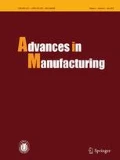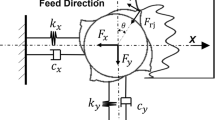Abstract
In recent years, there has been a significant increase in the utilization of Al/SiC particulate composite materials in engineering fields, and the demand for accurate machining of such composite materials has grown accordingly. In this paper, a feed-forward multi-layered artificial neural network (ANN) roughness prediction model, using the Levenberg-Marquardt backpropagation training algorithm, is proposed to investigate the mathematical relationship between cutting parameters and average surface roughness during milling Al/SiC particulate composite materials. Milling experiments were conducted on a computer numerical control (CNC) milling machine with polycrystalline diamond (PCD) tools to acquire data for training the ANN roughness prediction model. Four cutting parameters were considered in these experiments: cutting speed, depth of cut, feed rate, and volume fraction of SiC. These parameters were also used as inputs for the ANN roughness prediction model. The output of the model was the average surface roughness of the machined workpiece. A successfully trained ANN roughness prediction model could predict the corresponding average surface roughness based on given cutting parameters, with a 2.08% mean relative error. Moreover, a roughness control model that could accurately determine the corresponding cutting parameters for a specific desired roughness with a 2.91% mean relative error was developed based on the ANN roughness prediction model. Finally, a more reliable and readable analysis of the influence of each parameter on roughness or the interaction between different parameters was conducted with the help of the ANN prediction model.








Similar content being viewed by others
Abbreviations
- ANN:
-
Artificial neural network
- CNC:
-
Computer numerical control
- PCD:
-
Polycrystalline diamond
- MMC:
-
Metal matrix composite
- \(V_{\text{c}}\) :
-
Cutting speed
- \(F_{\text{r}}\) :
-
Feed rate
- \(D_{\text{c}}\) :
-
Depth of cut
- \(\varphi_{\text{SiC}}\) :
-
Volume fraction of SiC
- \(o_{m}^{k}\) :
-
Output of the mth neuron in the layer under consideration
- \(o_{n}^{k - 1}\) :
-
Output of the nth neuron in the preceding layer
- \(w_{mn}\) :
-
Weight value of the connection between the mth neuron in the layer under consideration and the nth neuron in the preceding layer
- \(b_{m}^{k}\) :
-
Bias value for the mth neuron in the layer under consideration
- \(f_{\text{activation}}\) :
-
Activation function
- \(R_{{{\text{a}}\_{\text{predicted}}}}\) :
-
Output roughness value by the prediction model
- \(R_{{{\text{a}}\_{\text{target}}}}\) :
-
Real roughness value of the milled surface
- \(E_{i}\) :
-
Error between \(R_{{{\text{a}}\_{\text{predicted}}\_i}}\) and \(R_{{{\text{a}}\_{\text{target}}\_i}}\) for the ith input vector
- \(S_{i}\) :
-
Squared error between \(R_{{{\text{a}}\_{\text{predicted}}\_i}}\) and \(R_{{{\text{a}}\_{\text{target}}\_i}}\) for the ith input vector
- \(\varvec{W}_{\text{bnew}}\) :
-
New weights-bias matrix which consists of all weights and biases updated over \(\varvec{W}_{\text{bold}}\) after the ith input vector used for training
- \(\varvec{W}_{\text{bold}}\) :
-
Old weights-bias matrix which consists of all weights and biases
- \(\varvec{J}\) :
-
Jacobian matrix
- \(P\) :
-
Number of elements in weights-bias matrix
- \(\varvec{I}\) :
-
Unit matrix
- \(\mu\) :
-
Adaptive factor
- \(P_{\text{model}}\) :
-
Roughness prediction model
- \(E_{\text{t}}\) :
-
Tolerable error
- ANOVA:
-
Analysis of variance
- BUE:
-
Built-up edge
References
Hekner B, Myalski J, Pawlik T et al (2017) Effect of carbon in fabrication Al-SiC nanocomposites for tribological application. Materials 10(6):679. https://doi.org/10.3390/ma10060679
Dong Z, Zheng F, Zhu X et al (2017) Characterization of material removal in ultrasonically assisted grinding of SiCp/Al with high volume fraction. Int J Adv Manuf Technol 93(5/8):2827–2839
Xiang J, Xie L, Gao F et al (2018) Methodology for dependence-based integrated constitutive modelling: an illustrative application to SiCp/Al composites. Ceram Int 44(10):11765–11777
Ozben T, Kilickap E, Cakir O (2008) Investigation of mechanical and machinability properties of SiC particle reinforced Al-MMC. J Mater Process Technol 198(1/3):220–225
Kennedy FE, Balbahadur AC, Lashmore DS (1997) The friction and wear of Cu-based silicon carbide particulate metal matrix composites for brake applications. Wear 203:715–721
Ravikiran A, Surappa MK (1997) Effect of sliding speed on wear behaviour of A356 Al-30 wt.%SiCp MMC. Wear 206(1/2):33–38
Chen J, Gu L, Liu X et al (2018) Combined machining of SiC/Al composites based on blasting erosion arc machining and CNC milling. Int J Adv Manuf Technol 96(1/4):111–121
Monaghan JM (1996) The use of a quick-stop test to study the chip formation of a SiC/Al metal matrix composite material and its matrix alloy. Int J Fatigue 18(3):213–217
Hocheng H, Yen SB, Ishihara T et al (1997) Fundamental turning characteristics of a tribology-favored graphite/aluminum alloy composite material. Compos A Appl Sci Manuf 28(9/10):883–890
Chan KC, Cheung CF, Ramesh MV et al (2001) A theoretical and experimental investigation of surface generation in diamond turning of an Al6061/SiCp metal matrix composite. Int J Mech Sci 43(9):2047–2068
Pramanik A, Zhang LC, Arsecularatne JA (2008) Machining of metal matrix composites: effect of ceramic particles on residual stress, surface roughness and chip formation. Int J Mach Tools Manuf 48(15):1613–1625
Manna A, Bhattacharyya B (2004) Investigation for optimal parametric combination for achieving better surface finish during turning of Al/SiC-MMC. Int J Adv Manuf Technol 23(9/10):658–665
Palanikumar K, Karthikeyan R (2007) Assessment of factors influencing surface roughness on the machining of Al/SiC particulate composites. Mater Des 28(5):1584–1591
Przestacki D, Szymanski P, Wojciechowski S (2016) Formation of surface layer in metal matrix composite A359/20SiCP during laser assisted turning. Compos A Appl Sci Manuf 91:370–379
Wojciechowski S, Nowakowski Z, Majchrowski R et al (2017) Surface texture formation in precision machining of direct laser deposited tungsten carbide. Adv Manuf 5(3):251–260
Kilickap E (2016) Effect of cutting environment and heat treatment on the surface roughness of drilled Al/SiC MMC. Mater Test 58(4):357–361
Kilickap E, Cakir O, Aksoy M et al (2005) Study of tool wear and surface roughness in machining of homogenized SiC-p reinforced aluminium metal matrix composite. J Mater Process Technol 164/165:862–867
Benardros PG, Vosniakos GC (2002) Prediction of surface roughness in CNC face milling using neural networks and Taguchi’s design of experiments. Robot Comput Integrated Manuf 18(5/6):343–354
Mahesh G, Muthu S, Devadasan SR (2015) Prediction of surface roughness of end milling operation using genetic algorithm. Int J Adv Manuf Technol 77(1/4):369–381
Kilickap E, Huseyinoglu M, Yardimeden (2011) A optimization of drilling parameters on surface roughness in drilling of AISI 1045 using response surface methodology and genetic algorithm. Int J Adv Manuf Technol 52(1/4):79–88
Khorasani AM, Yazdi MRS, Safizadeh MS (2011) Tool life prediction in face milling machining of 7075 Al by using artificial neural networks (ANN) and Taguchi design of experiment (DOE). Int J Eng Technol 3(1):30–35
Pimenov DY, Hassui A, Wojciechowski S et al (2019) Effect of the relative position of the face milling tool towards the workpiece on machined surface roughness and milling dynamics. Appl Sci 9(5):842. https://doi.org/10.3390/app9050842
Bustillo A, Correa M (2012) Using artificial intelligence to predict surface roughness in deep drilling of steel components. J Intell Manuf 23(5):1893–1902
Rodríguez JJ, Quintana G, Bustillo A et al (2017) A decision-making tool based on decision trees for roughness prediction in face milling. Int J Comput Integr Manuf 30(9):943–957
Çelik YH, Kilickap E, Yardimeden A (2014) Estimate of cutting forces and surface roughness in end milling of glass fiber reinforced plastic composites using fuzzy logic system. Sci Eng Compos Mater 21(3):435–443
Lin JT, Bhattacharyya D, Kecman V (2003) Multiple regression and neural networks analyses in composites machining. Compos Sci Technol 63(3/4):539–548
Mia M, Królczyk G, Maruda R et al (2019) Intelligent optimization of hard-turning parameters using evolutionary algorithms for smart manufacturing. Materials 12(6):879. https://doi.org/10.3390/ma12060879
Bustillo A, Díez-Pastor JF, Quintana G et al (2011) Avoiding neural network fine tuning by using ensemble learning: application to ball-end milling operations. Int J Adv Manuf Technol 57(5/8):521. https://doi.org/10.1007/s00170-011-3300-z
Kilickap E, Yardimeden A, Çelik YH (2017) Effect of cutting environment and heat treatment on the surface roughness in milling of Ti-6242S. Appl Sci 7(10):1064. https://doi.org/10.3390/app7101064
Manna A, Bhattacharayya B (2003) A study on machinability of Al/SiC-MMC. J Mater Process Technol 140(1/3):711–716
Xiang JF, Pang SQ, Xie LJ et al (2018) Investigation of cutting forces, surface integrity, and tool wear when high-speed milling of high-volume fraction SiCp/Al6063 composites in PCD tooling. Int J Adv Manuf Technol 98:1237–1251
Yuan ZJ, Geng L, Dong S (1993) Ultraprecision machining of SiCw/Al composites. CIRP Ann 42(1):107–109
Sahoo AK, Pradhan S (2013) Modeling and optimization of Al/SiCp MMC machining using Taguchi approach. Measurement 46(9):3064–3072
Khorasani AM, Yazdi MRS, Safizadeh MS (2011) Tool life prediction in face milling machining of 7075 Al by using artificial neural networks (ANN) and Taguchi design of experiment (DOE). Int J Eng Technol 3(1):30–35
Gologlu C, Sakarya N (2008) The effects of cutter path strategies on surface roughness of pocket milling of 1.2738 steel based on Taguchi method. J Mater Process Technol 206(1/3):7–15
YalcinU Karaoglan AD, Korkut I (2013) Optimization of cutting parameters in face milling with neural networks and Taguchi based on cutting force, surface roughness and temperatures. Int J Prod Res 51(11):3404–3414
El-Gallab M, Sklad M (1998) Machining of Al/SiC particulate metal-matrix composites: part I:tool performance. J Mater Process Technol 83(1/3):151–158
Grzenda M, Bustillo A, Zawistowski P (2012) A soft computing system using intelligent imputation strategies for roughness prediction in deep drilling. J Intell Manuf 23(5):1733–1743
Pala M, Caglar N, Elmas M et al (2008) Dynamic soil-structure interaction analysis of buildings by neural networks. Constr Build Mater 22(3):330–342
Hagan MT, Demuth HB, Beale MH (1996) Neural network design. PWS Pub. Co., Boston, p 3632
Hagan MT, Menhaj MB (1994) Training feed forward networks with the Marquardt algorithm. IEEE Trans Neural Netw 5(6):989–993
MacKay David JC (1991) Bayesian interpolation. Neural Comput 4(3):415–447
Bustillo A, Grzenda M, Macukow B (2016) Interpreting tree-based prediction models and their data in machining processes. Integr Comput Aided Eng 23(4):349–367
Karabulut Ş (2015) Optimization of surface roughness and cutting force during AA7039/Al2O3 metal matrix composites milling using neural networks and Taguchi method. Measurement 66:139–149
Acknowledgements
This work was supported by the National High Technology Research and Development Plan of China (Grant No. 2015AA043505), the Equipment Advanced Research Funds (Grant No. 61402100401), the Equipment Advanced Research Key Laboratory Funds (Grant No. 6142804180106) and Shenzhen Fundamental Research Funds (Grant No. JCYJ20180508151910775).
Author information
Authors and Affiliations
Corresponding author
Appendix
Appendix
See Tables 12, 13, 14, 15, 16, 17, 18, 19, 20, 21, 22, and 23.
Rights and permissions
About this article
Cite this article
Zhou, G., Xu, C., Ma, Y. et al. Prediction and control of surface roughness for the milling of Al/SiC metal matrix composites based on neural networks. Adv. Manuf. 8, 486–507 (2020). https://doi.org/10.1007/s40436-020-00326-x
Received:
Revised:
Accepted:
Published:
Issue Date:
DOI: https://doi.org/10.1007/s40436-020-00326-x



